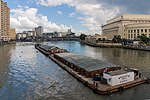North–South Harbor Bridge
Asian bridge (structure) stubsBridges in ManilaPasig RiverPhilippine building and structure stubsProposed bridges in the Philippines
The North and South Harbor Bridge is an upcoming cable-stayed bridge that will connect Barangay 20 (Parola) in the North Harbor and Barangay 649 (Baseco Island) in the South Harbor of the Port of Manila. It will cross over the Pasig River and is parallel to the M. Roxas Jr. Bridge (Delpan Bridge). Civil works are expected to begin in 2021 and the bridge is scheduled to be completed and operational by 2023.
Excerpt from the Wikipedia article North–South Harbor Bridge (License: CC BY-SA 3.0, Authors).North–South Harbor Bridge
Baseco Esplanade, Manila Port Area (Fifth District)
Geographical coordinates (GPS) Address Nearby Places Show on map
Geographical coordinates (GPS)
| Latitude | Longitude |
|---|---|
| N 14.594444444444 ° | E 120.95555555556 ° |
Address
Baseco Esplanade
Baseco Esplanade
1018 Manila, Port Area (Fifth District, Gawad Kalinga Habitat for Humanity Village)
Philippines
Open on Google Maps









